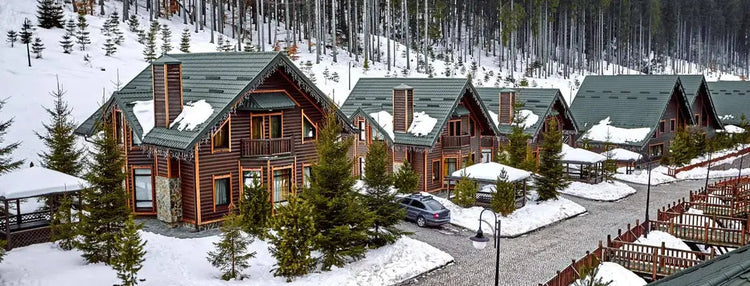
What Makes a D-Log Cabin So Special?
When you start thinking of building a log home, one of the first terms you're likely to hear is the D-log. In fact, D-logs and the D-log cabin building system are easy to understand and worth knowing about, since they’re one of the smartest and most popular options available for a log home.
What is a D-Log?
The D-log style is named after the shape of the logs used in construction, which are flattened on one or two sides to create a flat surface that is stacked horizontally to form the walls of the cabin. With the interior side milled flat and the exterior side curved, like the capital letter D.
What are the Advantages of the D-Log Shape?
- Easier To Build: The flat side makes the logs easier to build with, there being no need to notch them as with round logs, and you can put wall studs right up against them. Or, if you want a natural wood interior finish, the smooth surface means not dust collects as on curved interior logs.
- Traditional Log Cabin Look: Meanwhile, on your home’s exterior, the rounded surface of the D-log gives you the coveted traditional look of a log cabin.
- Tight Seal: One of the unique features of the D-log style log cabin is the way the logs interlock at the corners. This creates a tight seal that helps to prevent air and moisture from entering the cabin. The interlocking corners also add to the structural integrity of the cabin, making it more durable and able to withstand harsh weather conditions.
How Are D-Logs Milled?
It’s important to note that Western Log Home Supply no longer mills logs and focuses primarily on the maintenance and care of log homes.
Below are tips on how to mill D-Logs properly to the highest industry standards:
- Logs should be milled with a double tongue and groove and put together with a double gasket to prevent air infiltration, maximizing the inherent energy efficiency of a log home.
- Unlike a single tongue and groove in the center, logs won’t allow water to seep in through capillary action, creating wet spots that can lead to decay.
- Log should be milled with lower exterior drip edges. These slightly curved lips allow rain water to drip off and away from your home’s exterior rather than collecting and seeping in.
- The logs should be cut using solid steel cutting heads tipped in tungsten carbide, a cutting material second in hardness only to that of diamonds. The result is a smooth finish with no rough spots and extremely accurate milling to within 1/16 of an inch. So everything fits together accurately.
- Logs should not be milled until they are absolutely dry. That means that, when they are milled, you will already know where the natural cracks in the wood are.
- Whenever you dry a piece of timber, you’ll get at least one crack in it. Logs should be turned during the drying process so the crack is on the top of the log, hidden by the tongue-and-groove, giving you more attractive log walls inside and out. Just think what a great benefit that is over building with logs that are milled while still green, possibly changing size and shape and developing cracks after walls have been built!
Maintenance Requirements for a
D-Log Cabin
While the D-log cabin style is known for its durability, it still requires regular maintenance to keep it in good condition. Here are some key maintenance requirements to keep in mind:
-
Treat the Logs with a Wood Preservative
The logs need to be treated with a wood preservative to protect them from moisture, insects, and other types of damage. This should be done every few years to ensure that the logs remain in good condition.
-
Check for Cracks and Gaps in the Logs
It’s important to periodically check for any cracks or gaps in the logs and fill them with caulking or chinking to prevent air and moisture from entering the cabin.
-
Keep the Roof and Gutters Clean
Another important aspect of maintaining a D-log style log cabin is to keep the roof and gutters clean and free of debris. This will help to prevent water from pooling on the roof and seeping into the cabin.
Regularly inspecting the roof and gutters for any signs of damage and repairing them promptly can also help to prevent more extensive damage to the cabin.
In brief, a good D-log system offers one of the best options available in a strong, secure, long-lasting, and attractive log home. It’s a beautiful and durable choice for homeowners who want to achieve a rustic and timeless look for their log homes. With its interlocking corners and sturdy construction, a D-log cabin can last for generations with proper maintenance.


